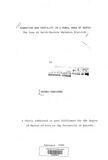| dc.description.abstract | This thesis is based on data collected from a sample survey conducted in north-western Machakos district between April and May 1978 for a multidisciplinary,
longitudinal population based study project of the Medical Research Centre, Nairobi.
A one-in-three systematic sample was drawn (from a universe of 7,238 females aged. 15 years and over), and 1,463 of them were interviewed. The survey, representing 20.2% of the entire female population in the 'Joint Project Machakos' study area as on’; February 1978,*attempts to investigate the relation • of migration to fertility and to examine the influence of several selected demographic and socioeconomic
factors on this relationship. It, further, examines the possible role of return migrants from urban places as agents of social change in the study area.
Migration status was defined in terms of birthplace data cross-tabulated with place-of- last-residence statistics, and then divided into three groups, namely, non-migrants, rural in-migrants and urban in-migrants. Fertility, on the other hand, was simply defined as the average number of children ever born to a respondent.
11
The analysis indicated that there was little variation in fertility between the migration categories,
even when controls for age and the intervening demographic and socio-economic factors that affect this relationship, were introduced. Apart from a strong case of marital status influencing fertility and migration status, it was found that the polygy- nously married women had virtually the same number of children ever born as their monogamously married counterparts. Further, whereas age at first marriage was inversely related to fertility, the in-migrants who tended to marry late, had slightly fewer children compared with their non-migrant counterparts who married early. Moreover, this difference was statistically not significant.
Similarly, the data amply demonstrated that migration and fertility in the context of this study, were definitely not related even when controls for age, education, labour force status and practice of modern contraception, were introduced. Particularly noteworthy, was the fact that, although the urban in-migrants registered the highest levels of education, participation in cash employment, practice of modern contraception, coupled with a late age at first marriage, their fertility did not differ significantly from those of their rural in-migrant and non-migrant
Ill
counterparts. These percentage differentials, in all likelihood, suggested that selectivity was in operation. But whether this selection drew only those who had failed to adjust to the urban way of life, or those who could not stay in urban places long enough to absorb the urban values, or those simply frustrated, calls for much more thought and intensive investigation using more samples. Certainly, despite the existence of a considerable volume of circulatory movements between the study area and urban places, there is no reason to believe that these return migrants in decades ahead, will promote social change nor transmit the knowledge, attitude and personal behaviour associated with low fertility from the urban places to the study area.
It is concluded that the present generalizations as to the direction of the influence of migration on fertility, are preliminary and should be submitted to closer scrutiny with additional data in the future. Other ethnic groups should also be studied particularly as comparative data would render such analyses more fruitful. Finally, inferences from this study to larger geographic domains, must be made cautiously. | en_US |



